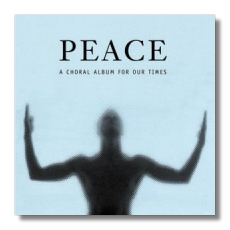
The Internet's Premier Classical Music Source
Related Links
-
Barber Reviews
Delius Reviews
Elgar Reviews
Górecki Reviews
Lauridsen Reviews
Rachmaninoff Reviews
Schoenberg Reviews
Tavener Reviews
Thompson Reviews
Victoria Reviews - Latest Reviews
- More Reviews
-
By Composer
-
Collections
DVD & Blu-ray
Books
Concert Reviews
Articles/Interviews
Software
Audio
Search Amazon
Recommended Links
Site News
 CD Review
CD Review
Peace

a Choral Album for Our Times
- Tomás Luis de Victoria: O magnum mysterium
- Randall Thompson: Alleluia
- Sergei Rachmaninoff: Blazen muzh
- Morten Lauridsen: O magnum mysterium
- Samuel Barber: Agnus Dei
- John Tavener: Song for Athene
- Arnold Schoenberg: Friede auf Erden
- Henryk Górecki: Totus Tuus
- Frederick Delius: To be sung of a summer night on the water
- Edward Elgar: Lux aeterna
Handel and Haydn Society Chorus/Grant Llewellyn
Avie AV0039 DDD 65:15
"a choral album for the times," reads the subtitle on the booklet cover, but has there been any time in history when peace and beauty weren't valued by the majority? In the booklet note, director Grant Llewellyn recounts that he arrived in Boston to take up his new appointment with the Handel and Haydn Society on the evening of September 10, 2001, the day before planes that departed Logan International Airport slammed into the World Trade Center in New York City. The music on this CD was selected to create an atmosphere of serenity, and an environment for reflection. "We hope that in this small way we are contributing to Peace on Earth," writes Llewellyn. (One notes that all the composers represented here are European or American, but I guess that the classical choral music of other continents remains out of the reach of most ensembles.)
Almost anyone who has spent much time even as a small-town chorister will have performed some of these works. Randall Thompson's Alleluia has been an essential part of the American choral repertoire for several decades, and Morten Lauridsen has quickly earned a reputation as one of today's most important and approachable composers of choral music. Harmonically, his O magnum mysterium is absolutely typical of his music.
Many readers will know that Barber's Adagio for Strings originally was part of a string quartet, but they might not know that Barber later arranged it for unaccompanied chorus as an Agnus Dei. (All of the works on this CD are a cappella.) Similarly, Elgar's Lux aeterna actually is an arrangement (not by Elgar) of the beloved "Nimrod" section of the orchestral Enigma Variations.
There are 32 members of the Handel and Haydn Society Chorus on this CD. Their performances do not emphasize showiness and overt drama; other groups have wrung more passion from Barber's Agnus Dei, for example, and the hypnotic figurations of Górecki's Totus Tuus have been made more insistent on other recordings. Above all, these are respectful, even devout readings. Not everything succeeds on this CD. I don't think that the chorus has the requisite dark sound for Rachmaninoff's Blazen muzh, for example, nor does it achieve the purity of style needed for Tomás Luis de Victoria's O magnum mysterium. The choristers are at their best in the American and English works, and much as one might deride Elgar's Lux aeterna, it is impossible not to be impressed with the intonation, blend, and control on display here.
The recording was made in the Church of the Redeemer in Chestnut Hill, Massachusetts. The engineers did a lovely job of capturing the chorus in a sympathetic environment.
Somewhat misleadingly, the booklet contains two photographs of singing children. They are members of the Society's Youth Choir. They do not perform here, but the photographs were included because its members are "our hope for the future." Ours too, we trust.
Copyright © 2004, Raymond Tuttle




















